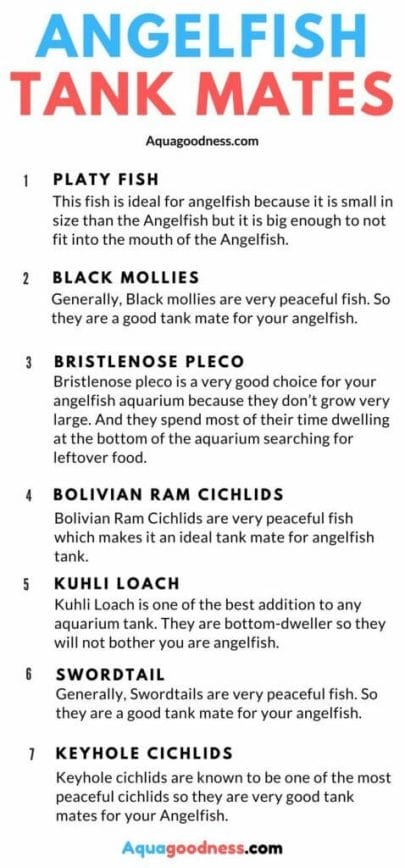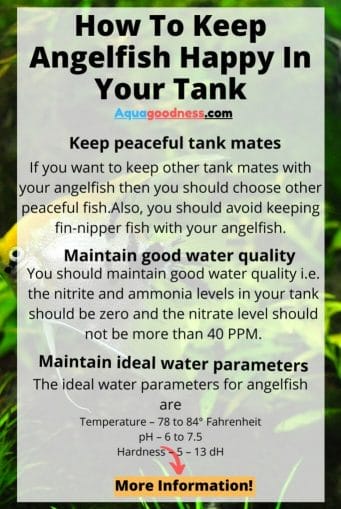You set up the Angelfish tank.
You made sure that you are following all the best practices.
You did everything you can to provide the ideal environment for your angelfish so that your angelfish can live happily in your aquarium.
But how do you actually know if you are angelfish is happy or not?
Well, this is the question I am going to answer in this article.
If your angelfish is eating whenever you feed it.
If you are angelfish is mostly swimming in the middle part of your tank.
And if you are not noticing any signs of disease on the body of your angelfish then you can say that you are angelfish is doing perfectly fine and is happy in your tank.

Table of Contents
Signs of a happy angelfish
There are a few signs that help you to understand if your angelfish is happy or not.
Eating
If your angelfish is eating properly.
That is whenever you feed your angelfish the fish readily eat the food then it is a sign that your fish is not suffering from any disease or is not stressed.
Swimming in the middle part of your tank
Angelfish mostly stay in the middle part of the tank.
So if your angelfish is mostly swimming in the middle part of your tank then it is a sign that your angelfish is doing fine in your tank.
No signs of diseases
If you do not notice any signs of disease such as clamped fins, fin rot, mouth rot, skin ulcer, pale coloring, white substance growth on the body or pores on the head of your angelfish then your angelfish is not suffering from any kind of disease.
And living happily in your tank.
How Long Do Angelfish Live For?
How can you tell if your angelfish is stressed?
There are few signs that can tell you if you are angelfish is stressed or not
Not eating
The first sign that can tell you your angelfish is stressed out is when the angelfish stops eating.
There would be several reasons that may cause this issue but usually, it is caused due to bad water quality or disease.
How Long Can Angelfish Go Without Food? (How often to feed)
Signs of diseases
Now this one is pretty obvious if you notice any signs of disease such as clamped fins, unnatural swimming, pores near the head, white cotton-like substance formed on the body of your angelfish, or any kind of fungal infection such as fin rot, mouth rot then it suggests that your fish is suffering from a disease and that’s why it is stressed.
Angelfish not growing or stunted
If you noticed only one among your angelfish is not growing like others then it is a sign that this fish is stressed.
Usually, it is caused when angelfish compete with each other and one angelfish dominates over the other.
It stresses the fish and it doesn’t grow properly.
Eventually, it can also cause the death of the fish.
How to recover a stressed angelfish?
If you notice any of the above signs then it suggests that your angelfish is stressed.
There are a few things you can do to recover your fish from the stress.
Maintain ideal water parameters
This one is very huge because if you notice your angelfish is stressed out and you do not know what’s causing the issue then it is most likely due to bad water quality.
Angelfish is a relatively hardy fish and can tolerate a decent range of water parameters but it is also very susceptible to diseases.
It cannot tolerate toxic nitrogen compounds like ammonia and nitrite.
Also, it cannot tolerate sudden changes in the water parameters.
So maintaining ideal water parameters is very important to destress your angelfish and make it happy and healthy again.
What Do Angelfish Like In Their Tank?
How to maintain the ideal environment in the tank?

pH and temperature
The first thing you should do is to check the pH and water temperature of your aquarium.
The ideal temperature for angelfish is between 78 to 84° Fahrenheit.
If you notice high water temperature then you can do these things to lower the water temperature.
If you noticed the low temperature in your tank then you should install a water heater in your tank. Checkout our heater recommendation.
The ideal pH range for the angelfish tank is between 6 to 7.5.
If you noticed high pH levels in your tank then you can easily reduce the pH by doing a partial water change.
Besides, there are a few other things you can do to reduce the pH such as:
- You can introduce driftwood into the tank.
- You can add almond leaves into the tank.
- You can add peat Moss into the tank.
- You can install reverse osmosis filter in your tank to reduce the pH of the water of your tank.
20 Tips to Maintain a Healthy Aquarium
Toxic nitrogen compounds
As mentioned earlier, angelfish is very intolerant of high levels of toxic nitrogen compounds.
Ideally, your tank should contain zero ammonia and nitrite.
And the nitrate level should be under 40 PPM.
High nitrogen compound levels such as ammonia and nitrite stress your angelfish that ultimately weakens the immune system of your fish.
And make it vulnerable to diseases.
Almost all the aquariums contain parasites that can cause disease to the fish.
And when your angelfish have a weak immune system these parasites can easily attack your fish.
So if you noticed high ammonia and nitrite level in your tank then the simplest way to reduce the levels is to do a partial water change.
How to do a partial water change?
You should change about 25% of the water of your tank every other day until the levels come down.
While replacing the water you should also make sure that the water you are going to add in your tank has roughly the same temperature as the temperature of the water in your tank.
This is to avoid a sudden change in the water temperature which can shock your fish.
You should also treat the water with a good tap water conditioner before adding it into the tank.
Also, before doing the water change you should remove any suspended debris in your tank.
You can also remove the debris from the substrate of your tank using a siphon. Check out our recommended Vaccum Cleaner or Siphon
Once the nitrogen compound levels are in control, you should then keep up with the water changes and change about 25% of the water of your tank every week.
You should also remove the debris from the substrate of your aquarium regularly.
But you should be very careful and do not deep clean the substrate.
Because the beneficial bacteria which are responsible for the nitrogen cycle create their colonies in this substrate so removing them can stall the nitrogen cycle.
Beneficial bacteria also create their colonies in the biological filters.
So, to preserve the beneficial bacteria, you should not remove all the filter components at once.
While cleaning the filter you should follow the best practices so that you are not accidentally removing beneficial bacteria from the filter.
What kind of tank do angelfish need? (Everything you need to know)
Keep peaceful tank mates
Angelfish have long fins and if you are keeping fin-nipper fish like Tiger barbs with your angelfish then it can really stress your angelfish.
Though Angelfish belongs to the Cichlids family, it is relatively peaceful fish.
So ideally you should keep other peaceful fish as tank mates with your angelfish.

13 Types of Angelfish for Your Freshwater Aquarium (With Images)
Maintain good oxygen levels
Fish require oxygen just as we do. And not having sufficient oxygen levels in the tank can suffocate your fish.
The signs that tell you your fish is not getting sufficient oxygen in your tank are as follows:
- If you noticed your fish coming on the surface of the water of your tank gasping for air then it is a sign that your angelfish is not getting sufficient oxygen.
- If you noticed rapid gills movements of your fish then it is a sign that your fish is struggling to get oxygen.
How to increase oxygen in the tank
There are several ways to increase oxygen in your tank.
- In an emergency, you can simply pure down the water of your aquarium from some height into the thank to increase the oxygen in the tank.
- While pouring down the water, the water will get exposed to the air which will help to increase oxygen levels.
- You can also do a water change of up to 50% of your tank to increase the oxygen level in your tank.
- The permanent solution to keep the oxygen levels in your tank at an optimum level is to get a HOB filter.
- The filtered water coming out from the HOB filter will fall into the tank from some height that will help to aerate the tank.
- You can also introduce an air pump to oxygenate the tank. Check out our recommended Air Pump
- You can also introduce some oxygenating plants into the tank that can help to increase oxygen in your tank.
Besides, there are several other ways to increase oxygen in your tank.

Are Angelfish Good for Beginners?
Treat the disease
If your angelfish is suffering from a disease then treating the disease is the solution to reduce stress from your angelfish.
How to treat a disease in angelfish
Viral infection
If you noticed symptoms of a viral infection such as lethargy, unnatural swimming, in your angelfish then, unfortunately, there is no treatment for viral infection besides supportive care such as keeping your tank clean and warm.
Also, even if the fish survive from the viral infection it still carries the virus and can pass it to other fish.
So you should keep the infected angelfish in a separate tank.
Bacterial infection
If you notice any signs of bacterial infection such as fin rot, mouth rot, pale coloring or skin ulcer then you can treat this bacterial infection using antibiotics in your tank to kill that will kill the harmful bacteria.
Fungal infection
If your fish has any open wounds then it can easily catch fungus.
A fungal infection is very easy to cause if the water quality of your tank is very bad.
The sign of fungal infection is white cotton-like substance growth on the body of your fish.
In the case of fungal infection, you should immediately do a partial water change of up to 30% of your tank.
If only one fish in your tank is affected due to the fungal infection then you should keep that fish in a separate tank and treat the infection.
You can find the recommendation to treat the fungus infection fungal infection from your local pet shop.
What can you do to keep your angelfish happy forever?

Are Angelfish Freshwater Or Saltwater?
There are several things you can do to keep your angelfish happy in your tank
Well cycled tank
As angelfish are intolerant to harmful toxic nitrogen compounds you should only put angelfish in a well-cycled tank.
That is the tank in which the nitrogen cycle is completed and ammonia and nitrate levels are zero and nitrate levels are not more than 40 PPM.
Acclimate the fish
Before adding the angelfish into the tank you should acclimate it properly.
You should hold the bag in which you brought the fish over the water of the tank for about 2 hours and then net out the fish into the tank.
Tank
Angelfish have a unique shape and its tank requirements are also different.
You should use a tall, large tank for angelfish so that it will have a lot of space to swim around and form its territory.
Maintain ideal water parameters
Maintaining ideal water parameters is very important for successfully keeping angelfish in the tank.
Angelfish cannot tolerate sudden fluctuations in the water parameters.
The ideal water parameters for angelfish are as follows:
- Temperature – 78 to 84° Fahrenheit
- pH – 6 to 7.5
- Hardness – 5 – 13 dH
You should regularly check the water parameters of your tank and always try to keep it under the ideal range.
52 Best Freshwater Aquarium Plants For Beginners (And Care Guide)
Keep peaceful tank mates
You should keep multiple angelfish in the same tank to promote social interaction.
If you want to keep other tank mates with your angelfish then you should choose other peaceful fish.
Also, you should avoid keeping fin-nipper fish with your angelfish.
Besides, you should also avoid keeping the fish that are very small in size like Neon tetra that can easily feet into the mouth of your angelfish.
Maintain good water quality
You should maintain good water quality i.e. the nitrite and ammonia levels in your tank should be zero and the nitrate level should not be more than 40 PPM.
Maintain optimum oxygen levels
Maintaining optimum oxygen levels in the tank is good for not only Angelfish but any fish in your tank.
So if you notice any signs of low oxygen like the fish coming to the surface very frequently and gasping for air, rapid gills moment of your fish then you should use these ways to increase oxygen in your tank.
7 Best Aquarium Plants For Angelfish
Conclusion
So there are a few signs that can tell you if you are angelfish is happy in your tank or not.
The first sign is if your angelfish is eating readily then it is a sign that your angelfish is not suffering from any disease and doing fine in your tank.
Angelfish like to swim in the middle part of the aquarium.
So if your angelfish is swimming in the middle part most of the time then your angelfish is doing fine in your tank.
Also, if you don’t notice any sign of disease in your angelfish then you can say that your angelfish is getting the ideal environment in your tank and is happy in your aquarium.
I hope you found this article helpful.
If you do, please share it.
As always, happy fish keeping!